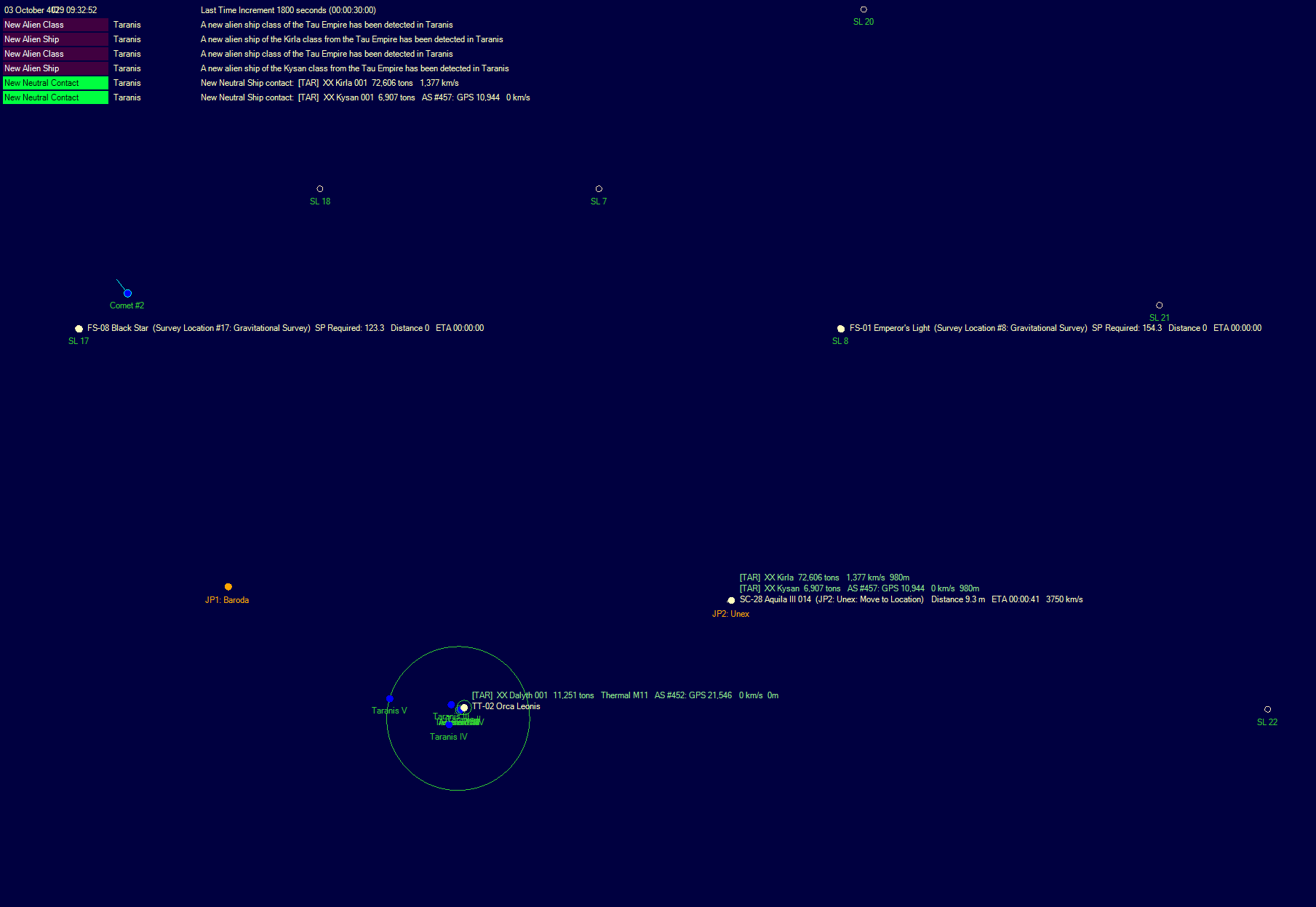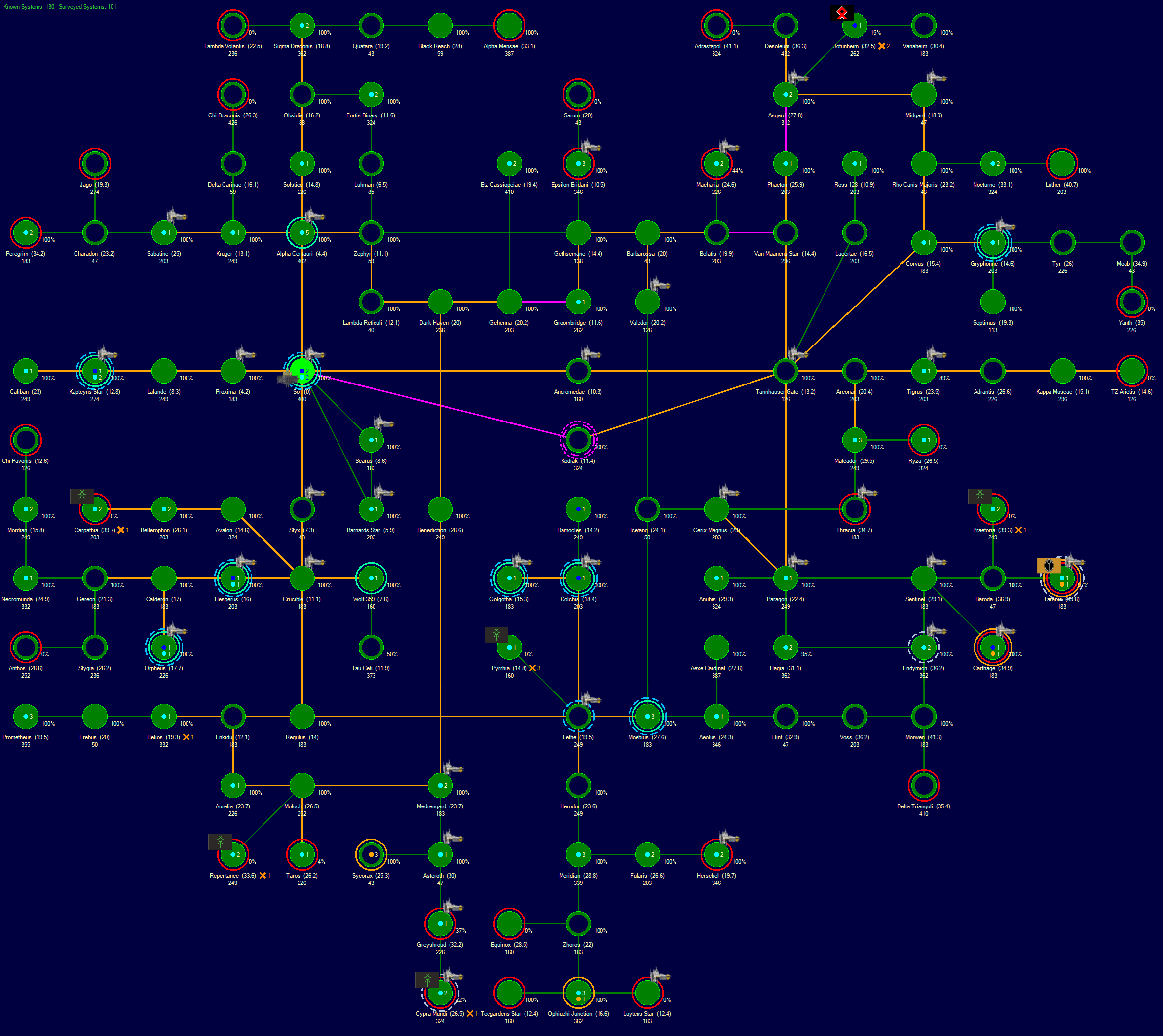On March 20th 4030, the Firestorm III class frigates Achilles, Medusa, Raven’s Spear and Thunderchild were launched from the Astaroth Shipyard. They were based on the same technology as the Dauntless III and Gothic II classes. All four immediately began brief refits to a new Firestorm III-B class that incorporated third generation EW jammers.
Firestorm III class Frigate 15,000 tons 534 Crew 4,218.2 BP TCS 300 TH 2,400 EM 3,570
8000 km/s JR 3-50 Armour 3-54 Shields 119-571 HTK 99 Sensors 6/11/0/0 DCR 9-6 PPV 75
Maint Life 1.57 Years MSP 2,081 AFR 200% IFR 2.8% 1YR 975 5YR 14,618 Max Repair 1,200 MSP
Captain Control Rating 4 BRG AUX ENG CIC
Intended Deployment Time: 12 months Morale Check Required
RM-150-B Military Jump Drive Max Ship Size 15000 tons Distance 50k km Squadron Size 3
Ravenor Drive Systems RDS-2400-MB2 (1) Power 2400 Fuel Use 24.94% Signature 2400 Explosion 12%
Fuel Capacity 369,800 Litres Range 17.8 billion km (25 days at full power)
Valentinian-Stern VS-119 Void Shield (1) Recharge Time 571 seconds (0.2 per second)
Valentinian-Ventris V12-240-B Particle Lance (2) Range 240,000km TS: 8,000 km/s Power 37-5.5 ROF 35
Astaroth Kinetics AK-30D Weapons Battery (4x4) Range 320,000km TS: 8,000 km/s Power 21-5.5 ROF 20
Astaroth Kinetics AK-10C Weapons Battery (5x4) Range 60,000km TS: 8,000 km/s Power 3-3 ROF 5
MK III Energy Weapon Fire Control (2) Max Range: 320,000 km TS: 8,000 km/s ECCM-2
R-50 Tokamak Fusion Reactor (1) Total Power Output 50.2 Exp 5%
MK III Frigate Active Augur Array (1) GPS 7560 Range 73.3m km Resolution 120
MK III Small Torpedo Detection Array (1) GPS 11 Range 6.1m km MCR 545.7k km Resolution 1
MK II Thermal Augur Array (1) Sensitivity 6 Detect Sig Strength 1000: 19.4m km
MK III Electromagnetic Augur Array (1) Sensitivity 11 Detect Sig Strength 1000: 26.2m km
Electronic Warfare Jammers: Fire Control 2 Missile 2
In April 4030, an Aquila scout detected a single Necron ship, designated as Phaeron class, in orbit of the first planet of the newly discovered Bloodfall system. The two recently constructed Gothic II-B class cruisers were dispatched to Bloodfall to eliminate the threat. On approach, they came under attack from a wave of fifty-one torpedoes moving at 34,555 km/s. The cruisers killed twelve torpedoes with their point defence, along with thirty-six decoys, leaving thirty-nine torpedoes still inbound. Only fifteen hit the cruiser Invincible with strength-7 warheads, dropping her shields to 85%. The rest missed due to the speed of the cruiser or potentially due to a degradation in accuracy from its third generation missile jammer.
After two more waves, with eleven and fifteen hits respectively, the senior commander, Lord Captain Arabella Typhon, ordered her two ships to cease point defence fire, relying only on shields, speed and ECM. Four more waves arrived, without any torpedo detonations affecting the cruisers’ armour. Five million kilometres from Bloodfall I, a ground force signature of 3800 tons was detected. At 400,000 km the cruisers came under fire from a Necron battery of thirteen surface-to-orbit bombardment cannon. The Imperial warships eliminated the surface weapons without any serious shield damage then launched their Thunderhawks in a boarding assault, as the undamaged Phaeron was plainly out of torpedoes. It was captured with minimal losses.
Phaeron class Orbital Defence Base 19,325 tons 376 Crew 3,006.8 BP TCS 386 TH 0 EM 0
1 km/s Armour 6-64 Shields 0-0 HTK 101 Sensors 11/11/0/0 DCR 8-4 PPV 137.7
Maint Life 0.55 Years MSP 777 AFR 373% IFR 5.2% 1YR 1,401 5YR 21,010 Max Repair 820.3 MSP
Magazine 3,172 / 96
Commander Control Rating 2 BRG AUX
Intended Deployment Time: 6 months Morale Check Required
Size 24 Decoy Launcher (4) Decoy Size: 24 Hangar Reload 245 minutes MF Reload 40 hours
Size 9 Missile Launcher (30.0% Reduction) (51) Missile Size: 9 Rate of Fire 720
Missile Fire Control FC120-R123 (2) Range 120.6m km Resolution 123 ECCM-2
Active Search Sensor AS127-R123 (1) GPS 23247 Range 127.9m km Resolution 123
Thermal Sensor TH1-11 (1) Sensitivity 11 Detect Sig Strength 1000: 26.2m km
EM Sensor EM1-11 (1) Sensitivity 11 Detect Sig Strength 1000: 26.2m km
Electronic Warfare Jammers: Sensor 2 Fire Control 2 Missile 2
Analysis of the ship confirmed that its missile fire controls only had second generation ECCM, so the deployment by the Imperial Navy of third generation jammers would reduce Necron accuracy in the future. A month after the battle,, the 1st and 4th Cadian Regiments landed on Bloodfall I and eliminated the small Necron ground force. A survey revealed a ruined outpost.
In June, a survey of Helican, located in presumed Tau space, revealed two jump points. Emperor’s Light transited the first and discovered Belis Corona, a system with a yellow G-5V primary, six planets and sixty moons. The outermost of twelve moons orbiting Belis Corona II, a gas giant, had liquid water and a thin nitrogen – oxygen atmosphere. There were three wrecks of unknown ships types in the inner system; one in orbit of the first planet – a Venusian world – and two between the orbits of the second and third planets, on opposite sides of the system. All three were less than 7500 tons. Emperor’s Light began a survey. As she had no remaining scouts, an old Aquila II was dispatched from Black Star, which was still in Helican, to check the inner system. Two new Aquila Vs were sent from Terra to replenish the strike groups of the survey frigates.
Two weeks after the entry into Belis Corona, thirty strength-7 detonations were detected in the inner system, close to one of the existing wrecks, followed by the appearance of a new 109,000 ton wreck of unknown type. As the Necron torpedoes used strength-7 warheads, Imperium Intelligence suspected the Tau could be fighting the Necrons in Belis Corona.
A second JP in Helican, explored by Black Star, led to Anvilus, a red dwarf system with six unremarkable planets. Small Tau populations, with EM signatures of strength-65 and strength-40 were detected on two moons of the fifth planet. These were the first known Tau colonies and further indicated that Helican, and now Anvilus, were on the route to the Tau core worlds. As Black Star continued her survey, she received several suggestions to leave the system. Given the mildness of the request, plus the fact that the Imperium did not take heed of alien demands, they were ignored. Geological results from the moons of the two colonies revealed why they were or interest to the Tau. From an Imperial perspective, the moons were too large for orbital mining platforms and too cold to easily terraform, so the Tau were probably using automated mines.
Anvilus V - Moon 12 Survey ReportDuranium: 317,169 0.90
Tritanium: 4,696 0.90
Boronide: 24,688 0.90
Mercassium: 39,839 1.00
Sorium: 107,008 0.90
Gallicite: 98,129 0.80
Anvilus V - Moon 18 Survey ReportDuranium: 3,144,362 0.90
Corbomite: 2,044,230 0.90
Vendarite: 3,919,730 0.90
Uridium: 193,228 0.50
Gallicite: 3,020,123 0.70
The Aquila II detached from Black Star to aid Emperor’s Light in Belis Corona was on approach to the second planet when it detected Active emissions from a Necron Shroud class destroyer on a reciprocal course at 5672 km/s. The Shroud was known to be 9,550 tons and armed with ten torpedo launchers. Before the Aquila II could enter active sensor range of either the Shroud or the planet it was destroyed by torpedoes. Imperium Intelligence’s theory about a Necron – Tau conflict now seemed very likely.
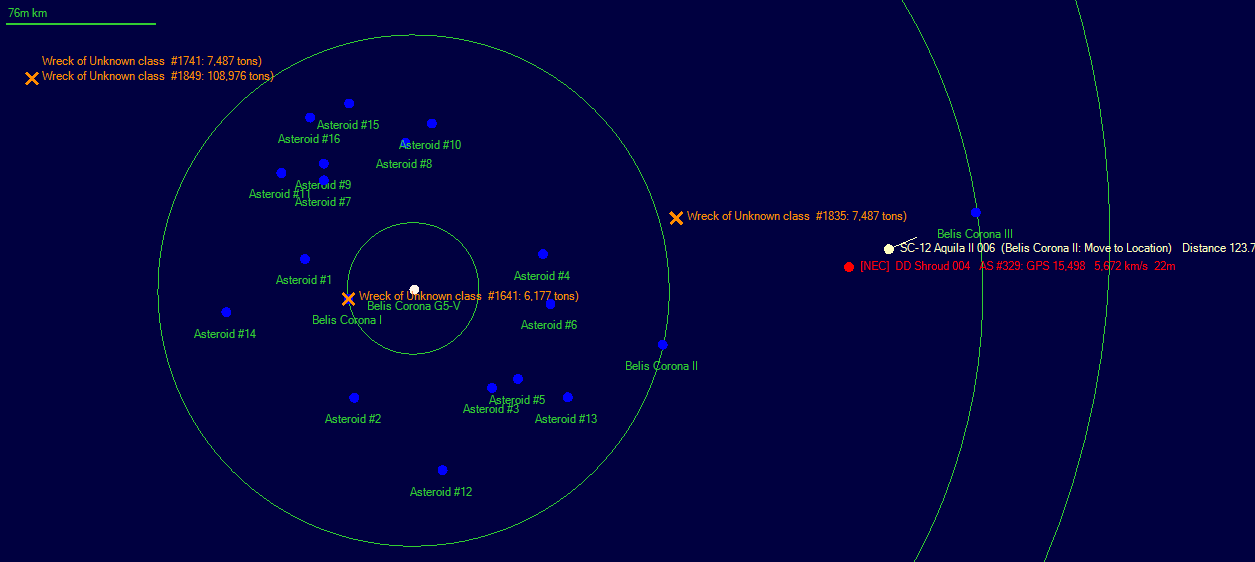
A few weeks later, the Starhawk-R arrived in Belis Corona, armed with a pair of Augur drones, attempting to discover what the lost Aquila scout could not. The Starhawk moved to the fifth planet, then launched a drone at the twelfth moon of the second planet, the only body with a nitrogen-oxygen atmosphere. The drone detected three 28,000 ton Scarabs, three Scythe escort cruisers, four destroyers and a Cryptek class escort, before being destroyed shortly thereafter by light torpedoes.
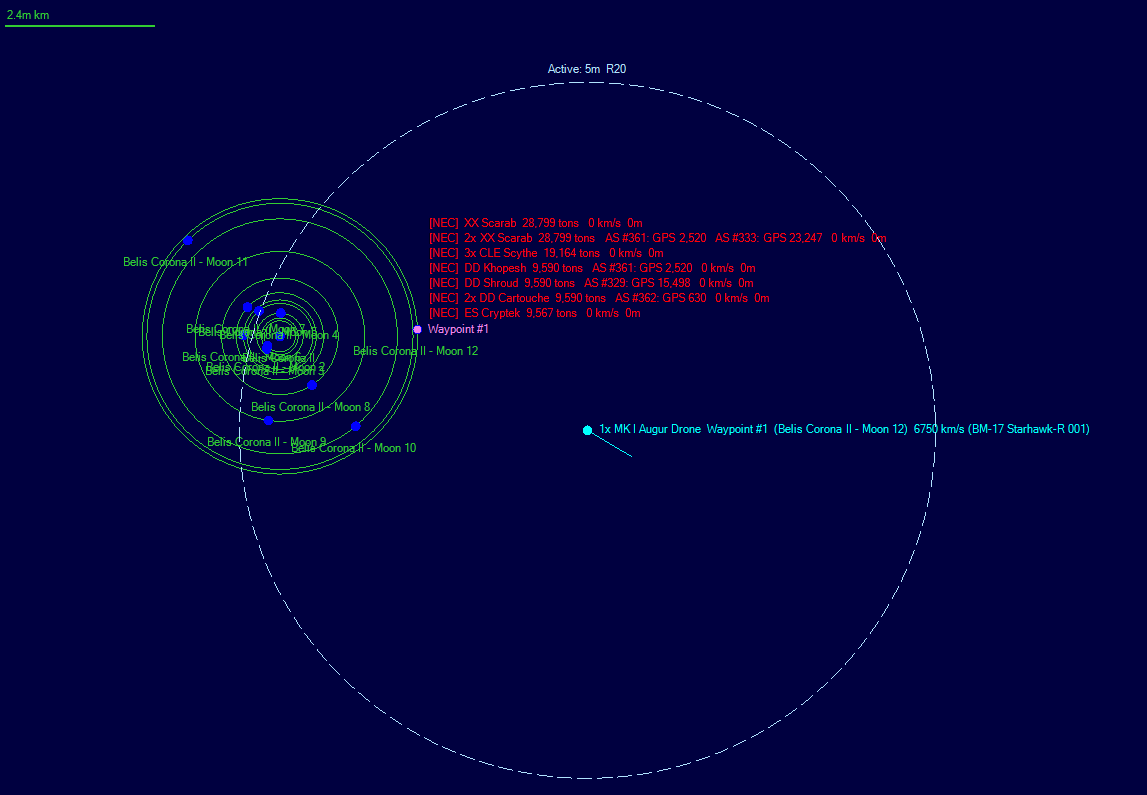
In August 4030, a task group comprising three Gothic cruisers and a new Dauntless III light cruiser was dispatched to subdue the Necron system of Carpathia. One of the cruisers was an older Gothic-B, with AK-25B weapon batteries and the original lance batteries rather than the more recent particle lances. Carpathia was discovered in December 4018, when an Aquila class scout was lost to torpedoes. A Starhawk-R mission four years later detected Necron forces in orbit of both the second and third planets. The four Imperial warships entered the system without challenge and confirmed the Necron forces remained unchanged during the intervening eight years.
Battlefleet CarpathiaGothic II-B class Cruiser: Holy Flame, Invincible
Gothic-B class Cruiser: Righteous Fury
Dauntless III class Light Cruiser: Vanguard
Necron Forces in orbit of Carpathia II1x OWP Phaeron 19,324 tons
1x MDB Dirge 19,271 tons
1x ODB Deathmark 19,212 tons
12x FAC Mephrit 979 tons.
Necron Forces in orbit of Carpathia III1x OWP Phaeron 19,324 tons
1x CLE Scythe 19,164 tons
1x DD Shroud 9,590 tons
1x DD Cartouche 9,590 tons
1x DD Khopesh 9,590 tons
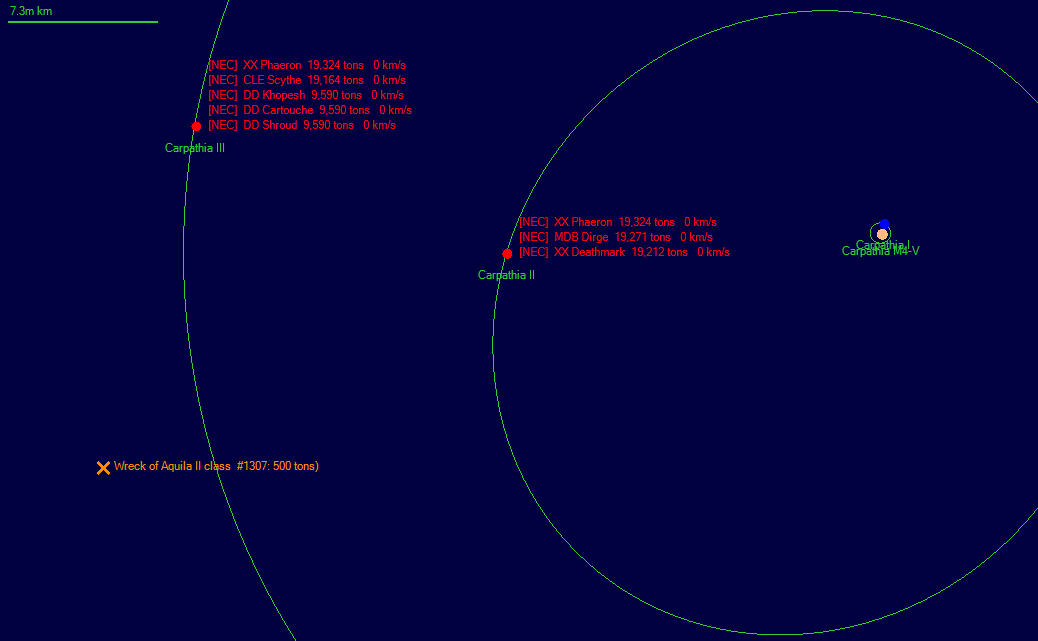
As both planets had a Phaeron class base, now known to be equipped with fifty-one torpedo launchers, Battlefleet Carpathia approached Carpathia III from a direction opposite to the location of Carpathia II. At forty-eight million kilometres, the fleet faced a wave of sixty-one torpedoes, presumably from the Phaeron and one of the destroyers. To conserve their maintenance supplies, the Imperium ships used only their AK-10 batteries for point defence. Twenty-two Necron torpedoes hit, reducing the shields of Righteous Fury by a third.
A second wave arrived ten minutes later, which was the normal interval for Necron torpedoes, but the third, just fifty-one torpedoes, arrived after only a six minute gap. The obvious conclusion was that the fleet was also coming under fire from the Phaeron at the second planet. The fleet faced fourteen main waves of torpedoes over the next hour, with occasional smaller waves of ten or twenty. A total of two hundred and sixty torpedoes impacted Imperium shields during that time, but never reduced the shields of any individual warship below fifty percent. Eventually the attacks ceased as the Necron bases and destroyers exhausted their ordnance.
At 1,250,000 kilometres from Carpathia III, the fleet came under fire from the Scythe class escort cruiser, which launched salvos of 32 light torpedoes every ten seconds. The majority were shot down by point defence and those that did impact had minimal effect, due to their strength-1 warheads. At 750,000 km, the Scythe and the three destroyers broke orbit and ran, leaving the Phaeron class base in orbit. There was no sign of surface-based weapons, so Battlefleet Carpathia moved into orbit and launched a Thunderhawk II against the undamaged Phaeron. Once the space marines were on the undamaged hull and the Thunderhawk back in its hangar bay, the fleet began pursuing the fleeing Necron ships. After several broadsides, the Shroud and the Khopesh were destroyed, while the Cartouche and Scythe were disabled and boarded. After the fleet’s space marines captured all three remaining Necron ships, Thunderhawks moved in to retrieve the marines while the fleet headed for Carpathia II, which had an orbital force comprising three bases and twelve fast attack craft. The immediate follow-up against the second planet was to distract the bases from any attack against the troop recovery operations.
On approach, Battlefleet Carpathia detected a large ground force signature of 36,000 tons, indicating both surface-to-orbit weapons and a large defensive force. The Phaeron in orbit was apparently still out of ordnance, but the fleet was attacked by the Dirge, armed with 42 light launchers. Missile fire was relatively ineffective, although the older cruiser Righteous Fury was gradually losing shield strength. At 360,000 km, twenty-six bombardment cannon, estimated to be 37cm in calibre, also attacked Righteous Fury, albeit with only one hit.
The fleet continued to close, targeting the Dirge with lances and the bombardment cannon with weapon batteries. The Necron fast attack craft fled. At 180,000 km, the fleet halted. Invincible suffered three strength-10 hits from the surface batteries and numerous hits from light torpedoes. Her shield strength remained above eighty percent. Amid heavy Imperial fire, the Dirge exploded, followed by the Deathmark. The surface weapons were wiped out by massed weapon batteries. The Phaeron was no immediate threat and could be boarded, but all three of the fleet’s marine boarding platoons were being retrieved from the ships captured near Carpathia III. To ensure the safety of those marines and the captured ships, the Phaeron was targeted and destroyed before it could reload.
Once recovered, the fleet’s space marines landed unopposed on Carpathia III and captured two deep space tracking stations, a refuelling station and an ordnance transfer station. Apart from the fleeing Necron FACs and the ground force on Carpathia II, the system was now secure. A few days later, after the cruisers had departed and left Vanguard to watch over the system in anticipation of landing operations on Carpathia II, the twelve FACs were detected by the tracking stations on Carpathia III, heading back in-system. Vanguard moved out to meet them in case they were armed, or possibly trying to re-arm or refuel on Carpathia II. She intercepted them fifteen million kilometres from Carpathia II and systematically blew them apart as they tried to move past her.
On September 25th 4030, Aegis, the third Dauntless III class light cruiser, was constructed at Terra. One day later, the survey frigate Tempest investigated a jump point in Macharia, six transits from Sol via the shortest route, and discovered Cadia, a system with an orange K2-V star, three terrestrial planets, a dwarf planet and a single moon, orbiting the fourth planet. Just outside the orbit of the second planet was a strange phenomenon; a vast rift in space ten million kilometres in diameter. Imperium Intelligence designated it as an ‘Aether Rift’, as it appeared to penetrate through both known space and the Aether to somewhere beyond. The Emperor decreed that a colony would be established to monitor the rift and determine its effects. As the second planet’s orbit passed close to the rift every ninety-five days a tracking station would be emplaced there, but the main colony would be on the fourth planet.
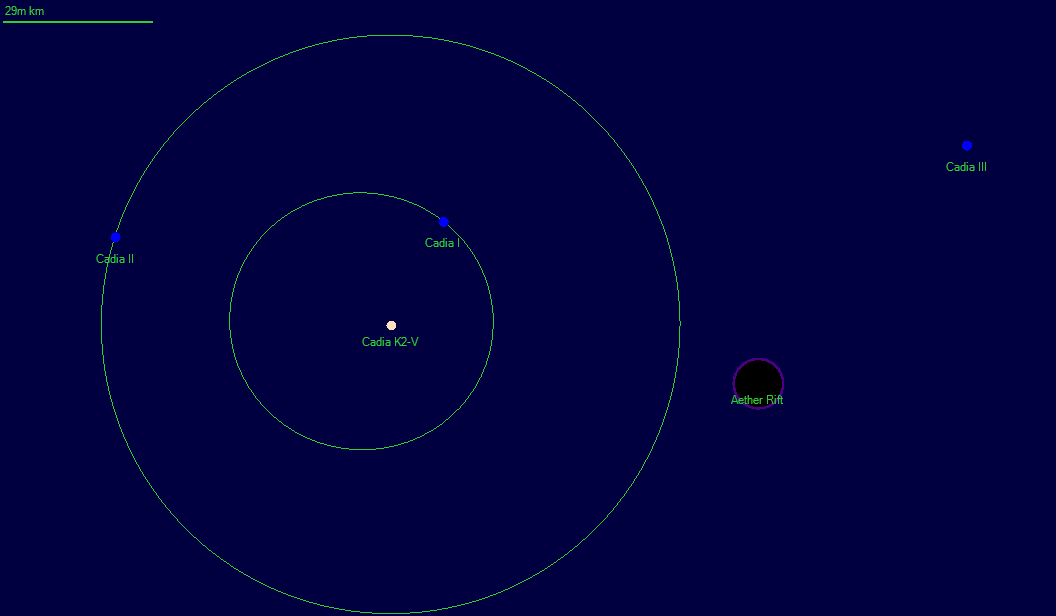
Meanwhile, in Anvilus, Black Star detected another Tau population, this time on an asteroid in the inner system that was large enough to retain an atmosphere. Anvilus was proving to be the home of numerous useful deposits. Tau suggestions to leave continued while the Imperial survey frigate was within their sensor range.
Asteroid #2 Survey ReportDuranium: 586,017 1.00
Corbomite: 242,275 0.70
Tritanium: 189,259 0.70
Vendarite: 181,888 0.60
Uridium: 114,189 0.80
Gallicite: 489,402 0.90
In November 4030, the Firestorm II-B class frigate Night Stalker, one of eight in her class, was refitted to the first Firestorm III-XB. This new class was identical to the Firestorm III-B with two exceptions. The engines were the older, less fuel efficient version of the latest Ravenor Drive Systems RDS-2400-MB2, which reduced the range to 14.8 billion kilometres, compared to 17.8b million for the III-B, and the AK-10 weapon batteries had a maximum range 10k km less than the latest AK-10C model. However, retaining the engines and the AK-10 weapon batteries from the II-B model reduced the refit cost from 97% of a new III-B to only 59%, with only a minimal sacrifice in capabilities. The refitted Firestorm III-XBs would be almost as capable as a new construction Firestorm III-B.
Firestorm III-XB class Frigate 15,000 tons 534 Crew 4,244.2 BP TCS 300 TH 2,400 EM 3,570
8000 km/s JR 3-50 Armour 3-54 Shields 119-571 HTK 99 Sensors 8/11/0/0 DCR 9-6 PPV 75
Maint Life 1.57 Years MSP 2,091 AFR 200% IFR 2.8% 1YR 975 5YR 14,625 Max Repair 1,200 MSP
Captain Control Rating 4 BRG AUX ENG CIC
Intended Deployment Time: 12 months Morale Check Required
RM-150-B Military Jump Drive Max Ship Size 15000 tons Distance 50k km Squadron Size 3
Ravenor Drive Systems RDS-2400-MB (1) Power 2400 Fuel Use 29.93% Signature 2400 Explosion 12%
Fuel Capacity 369,800 Litres Range 14.8 billion km (21 days at full power)
Valentinian-Stern VS-119 Void Shield (1) Recharge Time 571 seconds (0.2 per second)
Valentinian-Ventris V12-240-B Particle Lance (2) Range 240,000km TS: 8,000 km/s Power 37-5.5 ROF 35
Astaroth Kinetics AK-30D Weapons Battery (4x4) Range 320,000km TS: 8,000 km/s Power 21-5.5 ROF 20
Astaroth Kinetics AK-10 Weapons Battery (5x4) Range 50,000km TS: 8,000 km/s Power 3-3 ROF 5
MK III Energy Weapon Fire Control (2) Max Range: 320,000 km TS: 8,000 km/s ECCM-2
R-50 Tokamak Fusion Reactor (1) Total Power Output 50.2 Exp 5%
MK III Frigate Active Augur Array (1) GPS 7560 Range 73.3m km Resolution 120
MK III Small Torpedo Detection Array (1) GPS 11 Range 6.1m km MCR 545.7k km Resolution 1
MK III Electromagnetic Augur Array (1) Sensitivity 11 Detect Sig Strength 1000: 26.2m km
MK III Thermal Augur Array (1) Sensitivity 8 Detect Sig Strength 1000: 22.4m km
Electronic Warfare Jammers: Fire Control 3 Missile 3
A week later, Imperial Wrath, one of the two Gothic-B class cruisers, was refitted to the Gothic II-XB. As with the Firestorm III-XB, this was a refit to create a design very close in capability to the latest new construction class, but retaining the less fuel efficient engines, resulting in lower endurance, and the older AK-10 point defence batteries. The total cost was fifty-nine percent that of a new Gothic II-B.
On December 13th, an Aquila II class scout from the survey frigate Covenant transited a jump point in Luyten’s Star, located nine jumps from Sol on the fringe of known space. She discovered a red dwarf star with a single planet: an ideal habitable world that was almost entirely ocean, apart from sub-tropical islands covering 3% of the surface. The system was named Medusa. She detected a surface EM signature less than 10% that of Terra and a ground forces signature of 28,000 tons, but there was no sign of ships or any orbital infrastructure. The scout moved into orbit to attempt communication with the unknown alien race. Imperium Intelligence postulated that this could be a large colony, given the size of the signature, rather than a home world.
Two months later, Covenant moved into Medusa and completed a survey of the lone planet. The mineral deposits were both substantial and accessible. Those deposits would greatly assist with the Imperium shortages of Neutronium and Gallicite and also allow the distribution of mines from large colonies that existed due to the availability of one specific mineral, such as Io for Neutronium and Hesperus for Mercassium. There was still no communication from the surface, so Imperium Intelligence theorised this could be an alien race that had yet to develop Trans-Newtonian physics, making this a potentially huge opportunity for the Imperium. The Emperor ordered the Imperial Navy to develop plans for a ground invasion, once the build-up for the Carpathia invasion had been concluded.
Medusa I Survey ReportDuranium: 1,494,900 0.90
Neutronium: 541,500 1.00
Corbomite: 496,200 0.50
Tritanium: 667,800 0.60
Boronide: 244,200 0.60
Mercassium: 444,300 1.00
Vendarite: 207,300 0.50
Sorium: 265,950 0.60
Uridium: 394,200 0.90
Corundium: 201,900 0.40
Gallicite: 222,000 0.70
The Taranis colony had been built up to a population of eight million. On that basis, the Imperium declared its sovereignty over the system in January 4031 and asked the Tau Empire to leave. The Tau agreed. As this was the only known route into Imperium space for the Tau, this created some degree of short term security. Longer term, the only real security would be provided by building up a sufficient force in Taranis to push the Tau away from Imperial colonies.
On March 5th 4031, the Imperium launched the invasion of Carpathia II. The invasion force comprised the newly trained Avalon Corps with four infantry regiments, the battle-hardened Janus Corps with two Cadian and two Janus regiments and the first battle test of the 1st and 2nd super-heavy tank regiments. The total force comprised approximately 25,000 Guardsmen. 2000 Chimera light tanks and 96 Baneblade super-heavy tanks. The Necron ground force had a signature of 29,000 ton signature, which likely meant around 100,000 tons in reality due to the effects of fortification on the sensor signature. The battle lasted five days. Imperial losses were approximately one quarter of the engaged guard regiments. No super-heavy tanks were lost.
Baneblade Super-heavy TankTransport Size (tons) 228 Cost 41.04 Armour 108 Hit Points 144
Annual Maintenance Cost 5.1 Resupply Cost 99
Super-Heavy Anti-Vehicle: Shots 1 Penetration 135 Damage 135
Heavy Crew-Served Anti-Personnel: Shots 6 Penetration 22.5 Damage 15
Heavy Crew-Served Anti-Personnel: Shots 6 Penetration 22.5 Damage 15
Two new Dauntless III-Bs, Bellerophon and Sacrament of Judgement were launched by the Alpheus Graving Dock orbital shipyard in June 4031. There were now five Dauntless III-Bs in service, along with four II-Bs and two of the original ion-engined Dauntless I. The combat arm of the Imperial Navy also included four cruisers, four light carriers and fourteen frigates. The support shipping had grown considerably over the last ten years. Thirty-six mass conveyors were in service, along with fourteen Jericho colony ships. Fifty-three fuel harvesters were in orbit of Saturn and forty-nine orbital miners were based at six different comet mining colonies. A total of sixty terraforming stations were operating at the new colony in Cadia, the research colony in Golgotha, the mining colony in Gryphonne that was the primary source of the Imperium’s Gallicite and a planet in Tigrus that would become a future source of Neutronium. A wide variety of other commercial-engined ships supported the Imperial economy or assisted in the deployment of the Imperial Navy.
Imperial Navy – June 4031Gothic II-B class Cruiser:
Holy Flame, InvincibleGothic II-XB class Cruiser:
Imperial WrathGothic-B class Cruiser:
Righteous FuryDauntless III-B class Light Cruiser:
Aegis, Bellerophon, Cerberus, Sacrament of Judgement, VanguardDauntless II-B class Light Cruiser:
Divine Crusade, Ravenor, Unbroken Vow, Vengeful MartyrDauntless class Light Cruiser:
Bloodhawk, DauntlessDefiant III-B class Light Carrier:
Archangel, Bellator Stoicus, Imperial GhostDefiant-B class Light Carrier:
DefiantFirestorm III-B class Frigate:
Achilles, Medusa, Raven's Spear, ThunderchildFirestorm III-XB class Frigate:
Night StalkerFirestorm II-B class Frigate:
Cape Wrath, Destiny's Hand, Final Silence, Order Absolute, Reaver’s Dismay, Silent Fire, Triumph of JunoFirestorm class Frigate:
Firestorm, Heroic EndeavourTempest IV-B class Survey Frigate:
Acta Sanctorum, Ascension, Black Star, Constantia, Evening Star, Morning Star, Red Dawn, Tempest, Truth Eternal, Vita BrevisTempest IV class Survey Frigate:
Covenant, Emperor's Light1x Daedalus class Intelligence Ship
6x Jericho III class Colony Ship
8x Jericho II class Colony Ship
10x Universe III class Mass Conveyor
12x Universe II class Mass Conveyor
14x Universe class Mass Conveyor
1x Atlas IV class Tug
3x Atlas III class Tug
2x Atlas II class Tug
1x Atlas class Tug
53x Ambrosia class Fuel Harvester Station
49x Hephaestus class Orbital Miner
60x Gaia class Terraforming Station
3x Phoenix II class Salvager
4x Gateway class Stabilisation Ship
4x Carrack IV class Freighter
12x Carrack III class Freighter
6x Orca IV class Troop Transport
4x Orca III class Troop Transport
19x Safe Harbour class Maintenance Base
4x Brigantine III class Replenishment Ship
3x Brigantine II class Replenishment Ship
1x Brigantine class Replenishment Ship
2x Empyrean II class Jump Tender
3x Empyrean class Jump Tender
2x Barque class Collier
1x Aether class Jump Tender Station
16x Raven class Intelligence Ship
3x Ambassador class Diplomatic Station


 Recent Posts
Recent Posts



